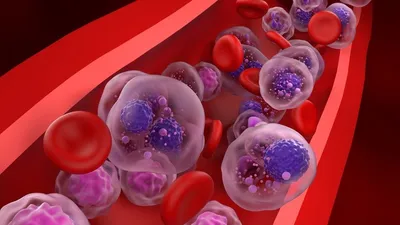Multiple Myeloma Measles Vaccine Clinical Trial Now Open at UAMS

Dr. van Rhee, MD PhD, MRCP, FRCPath of UAMS and Dr. Stephen Russell, MD, PhD of the Mayo Clinic are collaborating to open a clinical trial at UAMS for further study of the measles vaccine. The goal is to replicate the amazing results of myeloma patient Stacy Erholtz now that the doctors are armed with additional information from the Phase I and II trials held at the Mayo Clinic.
The objective is to use measles vaccine as virotherapy to attack the myeloma cells, but leave the remaining human cells intact. The desired outcome is a treatment with greatly reduced toxicity that provides the potential for durable, treatment-free remission. In this trial, unlike the Mayo Clinic trial which is using the measles vaccine alone, the measles vaccine is combined with cyclophosphamide (Cytoxan) to give the vaccine more time to work before the body's immune system wakes up and prevents the virus from killing the myeloma cells. This trial will also use a lower dose of the measles vaccine because it is being paired with Cytoxan. Dr. Russell describes why the addition of Cytoxan will be used: 
What cyclophosphamide does is it substantially slows and delays the immune response to the virus, so by giving cyclophosphamide along with the virus ... we’ll be slowing the immune system and giving the virus a much better opportunity to spread for a longer period of time in the cancer, thereby leading to more tumor destruction.
In the trial, patients with relapsed/refractory disease that have failed standard therapies are invited to participate. Non-secretory patients are welcome to join as well. A major factor of eligibility is that patients have no detectable measles antibody. If this is present, it prevents the vaccine from working. About a third of all myeloma patients tested will have this lack of measles antibody, regardless of whether they have had measles before or have been vaccinated. Dr. Russell describes Stacy's situation and what is commonly found in myeloma patients.
Well, interestingly, Stacy had been vaccinated both as a child and two years following her first stem cell transplant, which was routine post-transplant vaccination protocol here at Mayo Clinic, but subsequently, she lost her anti-measles antibody and this is a very important feature of multiple myeloma, is that because it suppresses the production of antibodies, myeloma patients often lose their antiviral immunity. That did happen with Stacy. It’s happened with many other myeloma patients. We have been evaluating many, many patients to determine what the antibody status is, how many of those patients have anti-measles antibody. What we’ve found is that about half of the myeloma patients we’ve tested do not have protective levels of anti-measles antibody, and about a third of the myeloma patients we’ve tested have virtually undetectable anti-measles antibody. And so, for the clinical trials that we’re doing with naked virus, where we haven’t attempted to mask the virus from the antibody neutralization, we’re focusing specifically on those patients who have virtually no detectable anti-measles antibody, so a third of the patients that we screen we expect to be eligible on that basis.

On the Myeloma Crowd Radio show, Dr. van Rhee described overall eligibility for this trial as follows:
The patients should have failed standard therapies and have more advanced disease, so they need to have relapsed disease. They need to have had at least one stem cell transplant and not be responding to an immunomodulatory drug or to a proteasome inhibitor. So we’re looking at patients with more advanced disease. There is no specified criterion that they necessarily need to have a low disease burden.
A unique feature of this trial is the use of imaging studies before and after treatment to determine whether the virus is working and where it is working in the body. Both cyclophosphamide and the measles vaccine have anti-myeloma effects, so how do researchers know which one is actually killing the myeloma? Both doctors describe its importance:
Dr. van Rhee: Dr. Russell modified this vaccine strain to allow for imaging, so we will be doing imaging studies to see where the virus goes and importantly, how long it’s going to persist and that it persists at sites where the myeloma is. So one of the things that is written in our trials grant proposal is to do additional imaging studies because it is of crucial importance that the virus doesn’t only have the chance to replicate and persist longer, but that it persists at the right site. Dr. Russell: The imaging is critically important for this because cyclophosphamide does have known activity against multiple myeloma. The ability to be able to independently track the propagation of the virus in the body using the imaging study is therefore crucial. So when we see responses, we’ll know what the relative contributions of the cyclophosphamide in the virus therapy are.
Two tests are run to see if patients are measles antibody-negative. According to Dr. Russell:
Well, there are actually two tests we do. One of them is a simple, straightforward lab test that’s available pretty much in any hospital lab. It’s a variation on something called an ELISA, and it’s just some beads. They have measles proteins on their surface and they’re mixed with the blood, and then they’re tested to see whether they capture the antibody. If they have, then you know that there was anti-measles antibody in the blood. The other test that we do is we add the patient’s blood to live measles virus in the lab here at Mayo and we determine whether the blood is able to neutralize the virus.
The trial follows these steps as outlined by Dr. van Rhee:
In terms of treatment, the patients get one dose of cyclophosphamide and the next day, they get the cyclophosphamide and they get the virus-infused, and they get for two further days cyclophosphamide-infused. So although they get four doses of cyclophosphamide and on the second day they get the virus, the four doses are chosen because we commonly use this in a regimen at our center called VDT-PACE and they are actually exactly the same doses as we use in the VDT-PACE, so we’re very familiar with the toxicity of the cyclophosphamide.
Safety is expected to be solid for this clinical trial as this strain of measles vaccine has been used for decades in billions of patients. Additionally, cyclophosphamide is a treatment that has been given for many years and its safety profile is well known. There are 16 patients expected to participate in the trial - one per month. For more information about the trial, please contact Jaclyn Lasha Fite at JLFite@uams.edu. or call 1-888-MYELOMA For more information about how the measles vaccine works in myeloma, listen to the first show on Myeloma Crowd Radio with Dr. Stephen Russell. For more detail explaining this specific clinical trial, listen to the recent Myeloma Crowd radio show with both Dr. van Rhee and Dr. Stephen Russell.
Dr. van Rhee, MD PhD, MRCP, FRCPath of UAMS and Dr. Stephen Russell, MD, PhD of the Mayo Clinic are collaborating to open a clinical trial at UAMS for further study of the measles vaccine. The goal is to replicate the amazing results of myeloma patient Stacy Erholtz now that the doctors are armed with additional information from the Phase I and II trials held at the Mayo Clinic.
The objective is to use measles vaccine as virotherapy to attack the myeloma cells, but leave the remaining human cells intact. The desired outcome is a treatment with greatly reduced toxicity that provides the potential for durable, treatment-free remission. In this trial, unlike the Mayo Clinic trial which is using the measles vaccine alone, the measles vaccine is combined with cyclophosphamide (Cytoxan) to give the vaccine more time to work before the body's immune system wakes up and prevents the virus from killing the myeloma cells. This trial will also use a lower dose of the measles vaccine because it is being paired with Cytoxan. Dr. Russell describes why the addition of Cytoxan will be used: 
What cyclophosphamide does is it substantially slows and delays the immune response to the virus, so by giving cyclophosphamide along with the virus ... we’ll be slowing the immune system and giving the virus a much better opportunity to spread for a longer period of time in the cancer, thereby leading to more tumor destruction.
In the trial, patients with relapsed/refractory disease that have failed standard therapies are invited to participate. Non-secretory patients are welcome to join as well. A major factor of eligibility is that patients have no detectable measles antibody. If this is present, it prevents the vaccine from working. About a third of all myeloma patients tested will have this lack of measles antibody, regardless of whether they have had measles before or have been vaccinated. Dr. Russell describes Stacy's situation and what is commonly found in myeloma patients.
Well, interestingly, Stacy had been vaccinated both as a child and two years following her first stem cell transplant, which was routine post-transplant vaccination protocol here at Mayo Clinic, but subsequently, she lost her anti-measles antibody and this is a very important feature of multiple myeloma, is that because it suppresses the production of antibodies, myeloma patients often lose their antiviral immunity. That did happen with Stacy. It’s happened with many other myeloma patients. We have been evaluating many, many patients to determine what the antibody status is, how many of those patients have anti-measles antibody. What we’ve found is that about half of the myeloma patients we’ve tested do not have protective levels of anti-measles antibody, and about a third of the myeloma patients we’ve tested have virtually undetectable anti-measles antibody. And so, for the clinical trials that we’re doing with naked virus, where we haven’t attempted to mask the virus from the antibody neutralization, we’re focusing specifically on those patients who have virtually no detectable anti-measles antibody, so a third of the patients that we screen we expect to be eligible on that basis.

On the Myeloma Crowd Radio show, Dr. van Rhee described overall eligibility for this trial as follows:
The patients should have failed standard therapies and have more advanced disease, so they need to have relapsed disease. They need to have had at least one stem cell transplant and not be responding to an immunomodulatory drug or to a proteasome inhibitor. So we’re looking at patients with more advanced disease. There is no specified criterion that they necessarily need to have a low disease burden.
A unique feature of this trial is the use of imaging studies before and after treatment to determine whether the virus is working and where it is working in the body. Both cyclophosphamide and the measles vaccine have anti-myeloma effects, so how do researchers know which one is actually killing the myeloma? Both doctors describe its importance:
Dr. van Rhee: Dr. Russell modified this vaccine strain to allow for imaging, so we will be doing imaging studies to see where the virus goes and importantly, how long it’s going to persist and that it persists at sites where the myeloma is. So one of the things that is written in our trials grant proposal is to do additional imaging studies because it is of crucial importance that the virus doesn’t only have the chance to replicate and persist longer, but that it persists at the right site. Dr. Russell: The imaging is critically important for this because cyclophosphamide does have known activity against multiple myeloma. The ability to be able to independently track the propagation of the virus in the body using the imaging study is therefore crucial. So when we see responses, we’ll know what the relative contributions of the cyclophosphamide in the virus therapy are.
Two tests are run to see if patients are measles antibody-negative. According to Dr. Russell:
Well, there are actually two tests we do. One of them is a simple, straightforward lab test that’s available pretty much in any hospital lab. It’s a variation on something called an ELISA, and it’s just some beads. They have measles proteins on their surface and they’re mixed with the blood, and then they’re tested to see whether they capture the antibody. If they have, then you know that there was anti-measles antibody in the blood. The other test that we do is we add the patient’s blood to live measles virus in the lab here at Mayo and we determine whether the blood is able to neutralize the virus.
The trial follows these steps as outlined by Dr. van Rhee:
In terms of treatment, the patients get one dose of cyclophosphamide and the next day, they get the cyclophosphamide and they get the virus-infused, and they get for two further days cyclophosphamide-infused. So although they get four doses of cyclophosphamide and on the second day they get the virus, the four doses are chosen because we commonly use this in a regimen at our center called VDT-PACE and they are actually exactly the same doses as we use in the VDT-PACE, so we’re very familiar with the toxicity of the cyclophosphamide.
Safety is expected to be solid for this clinical trial as this strain of measles vaccine has been used for decades in billions of patients. Additionally, cyclophosphamide is a treatment that has been given for many years and its safety profile is well known. There are 16 patients expected to participate in the trial - one per month. For more information about the trial, please contact Jaclyn Lasha Fite at JLFite@uams.edu. or call 1-888-MYELOMA For more information about how the measles vaccine works in myeloma, listen to the first show on Myeloma Crowd Radio with Dr. Stephen Russell. For more detail explaining this specific clinical trial, listen to the recent Myeloma Crowd radio show with both Dr. van Rhee and Dr. Stephen Russell.
about the author
Jennifer Ahlstrom
Myeloma survivor, patient advocate, wife, mom of 6. Believer that patients can contribute to cures by joining HealthTree Cure Hub and joining clinical research. Founder and CEO of HealthTree Foundation.
Trending Articles
Upcoming Events




Get the Latest Multiple Myeloma Updates, Delivered to You.
By subscribing to the HealthTree newsletter, you'll receive the latest research, treatment updates, and expert insights to help you navigate your health.
Together we care.
Together we cure.
3x Faster.










